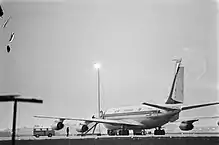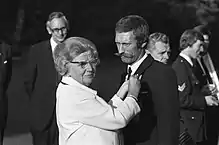Pim Sierks
Henderikus "Pim" Sierks (born 10 March 1932) is a former airline pilot who most notably captained a Boeing 707 full of hostages and hostage takers during the 1974 French Embassy attack in The Hague.[1]
Pim Sierks | |
|---|---|
.jpg.webp) Sierks In 1974 | |
| Born | Henderikus Sierks March 10, 1932 |
| Nationality | Dutch |
| Known for | Captained a Boeing 707 with hostage takers from the French Embassy attack in The Hague |
| Aviation career | |
| Air force | Royal Netherlands Air Force |
He was a member of the Royal Netherlands Air Force for over 11 years and had flown many Dutch fighter jets. Upon retirement from the Air Force he worked as an airline pilot for Dutch airline Transavia.
Early life and military career
Sierks was born on March 10, 1932 in Haren, Groningen in the Northern part of the Netherlands. He enrolled in the Royal Netherlands Air Force and was sent to Canada where he trained with the Royal Canadian Air Force. He trained there on the Airspeed Horsa, Auster AOP.6 and the Avro 626. Upon returning to the Netherlands Sierks was based at the Deelen Air Base then later at the Leeuwarden Air Base near Leeuwarden.
While in the Netherlands Sierks was assigned to the Hawker Hunter which he flew for the majority of his Air Force career.
Involvement in the French Embassy attack
Three members of the Japanese Red Army (JRA) stormed the French Embassy in The Hague, on the orders to have a fellow JRA member released from the Netherlands. Other demands were for significant amount of money and the use of a French airplane to escape on. Fearing possible retaliation if not complied with the French government sent a Boeing 707 to the Netherlands. However, there was not a crew to fly the 707 out of the Netherlands, so since Transavia was the only airline in The Netherlands at the time to fly Boeing aircraft French and Dutch officials asked for Transavia to provide a crew.[2]

Sierks volunteered as well as first officer Ruud van der Zwaal to pilot the flight. Prior to the flight the JRA members had not announced where the wanted to be flown to. So Sierks had a meeting with the JRA members inside the Embassy on the morning of September 17. The meeting lasted 25 minutes, Sierks and the hostage takers made a deal that Sierks would not reveal the destination to anyone except his first officer in exchange for the safety of the aircraft and crew. The JRA members wanted to fly to Damascus, Syria however the 707 hadn’t have enough fuel to fly direct. So Aden, Yemen was selected as a refueling stop.
The 707 took off from Amsterdam Airport Schiphol bound for Aden International Airport they aircraft refueled and took off from Aden within 30 minutes. The flight then flew from Aden to Damascus International Airport. Upon arrival in Damascus and in accordance to the agreement the hostage takers surrendered their weapons to the crew and left the money as well. Upon landing in Damascus and the deplaning of the hostage takers Sierks and Van Der Zwaal returned the weapons and money to the French Embassy in Damascus.[3]
Legacy

After the flight Sierks became a national hero. For his heroism he received multiple national awards including the Knight Grand Cross of the Order of Orange-Nassau which was appointed to him by Juliana of the Netherlands. Other awards include the Order of the Netherlands Lion, and Airman's Cross.[4]
Awards and honors
 : Knight Grand Cross of the Order of Orange-Nassau
: Knight Grand Cross of the Order of Orange-Nassau : Order of the Netherlands Lion
: Order of the Netherlands Lion : Airman's Cross
: Airman's Cross
References
- "Pim Sierks biography and facts". IMDb. Retrieved 20 May 2018.
- "Frankrijk wil geen bemanning leveren en Transavia is de enige Nederlandse maatschappij die met een Boeing ..." Andere Tijden (in Dutch). 19 June 2015. Retrieved 20 May 2018.
- "Wie de term heeft bedacht weet ik niet, maar mijn familie is er niet mee gezegend". boemblog.nl (in Dutch). 20 June 2015. Retrieved 20 May 2018.
- "Transavia-gezagvoerder Pim Sierks (42) loopt hier van de Franse ambassade naar het ministerie van Justitie, nadat hij dinsdagmiddag een bespreking van ongeveer een kwartier had met de terroristen over de". Europeana.eu (in Dutch). Retrieved 20 May 2018.